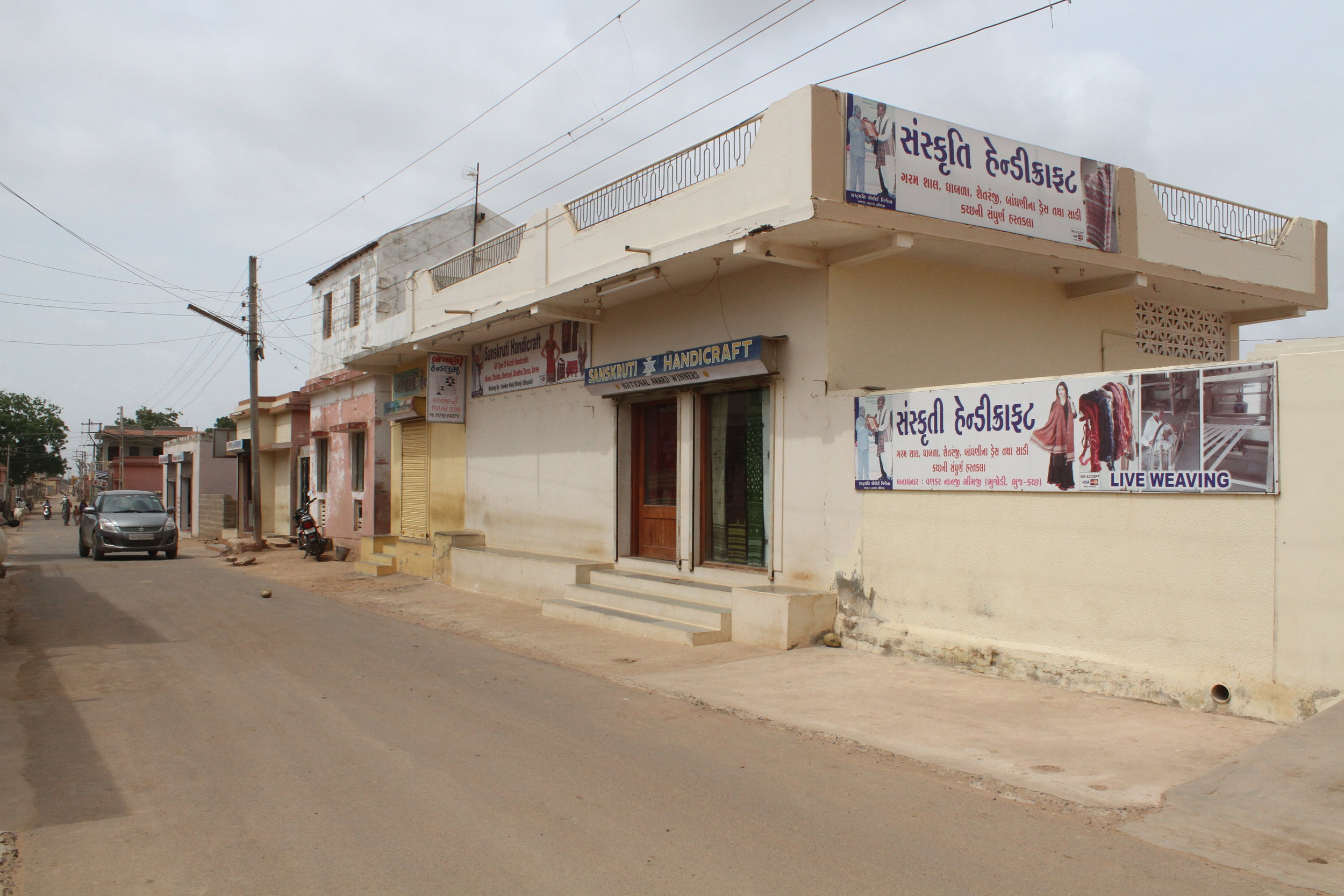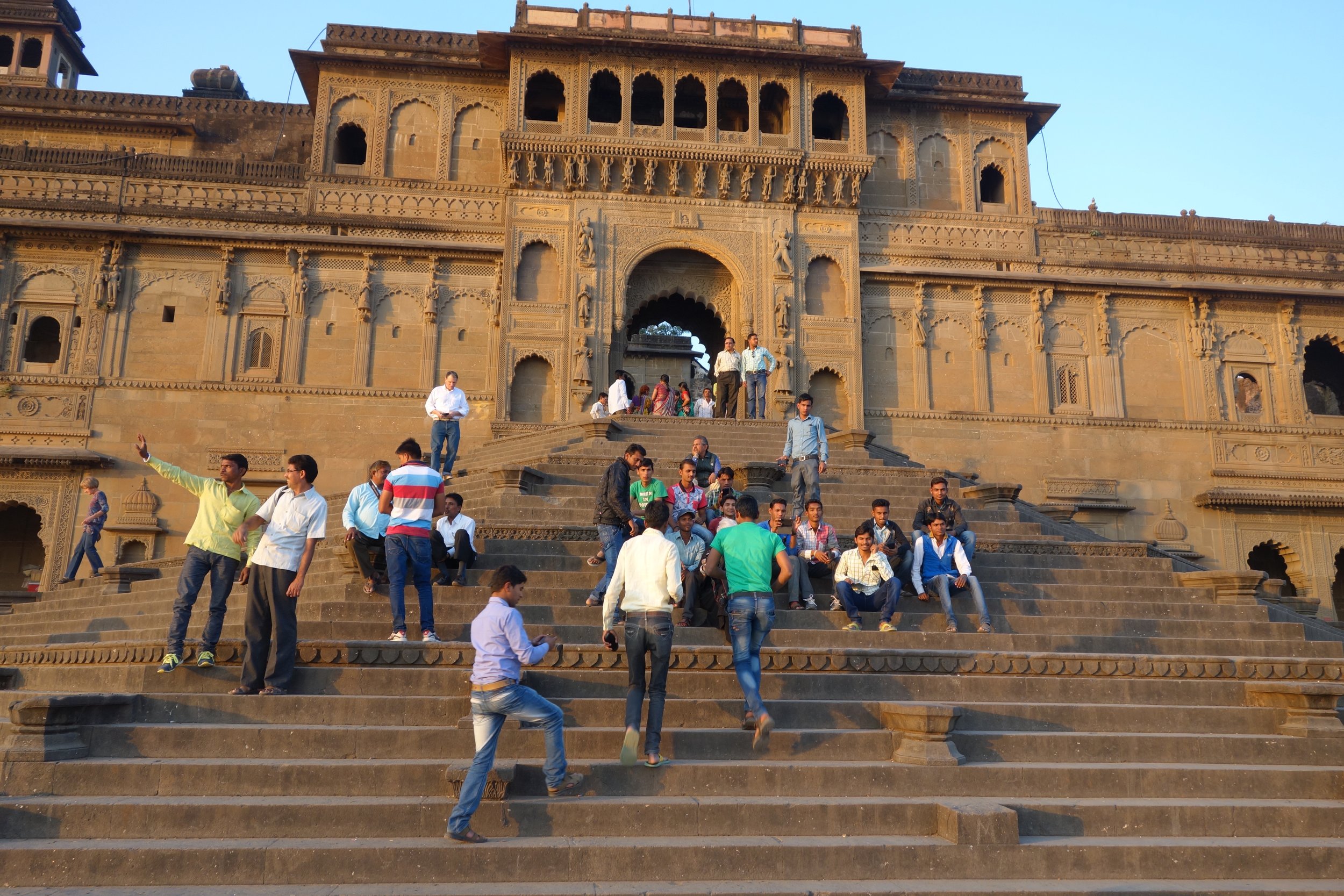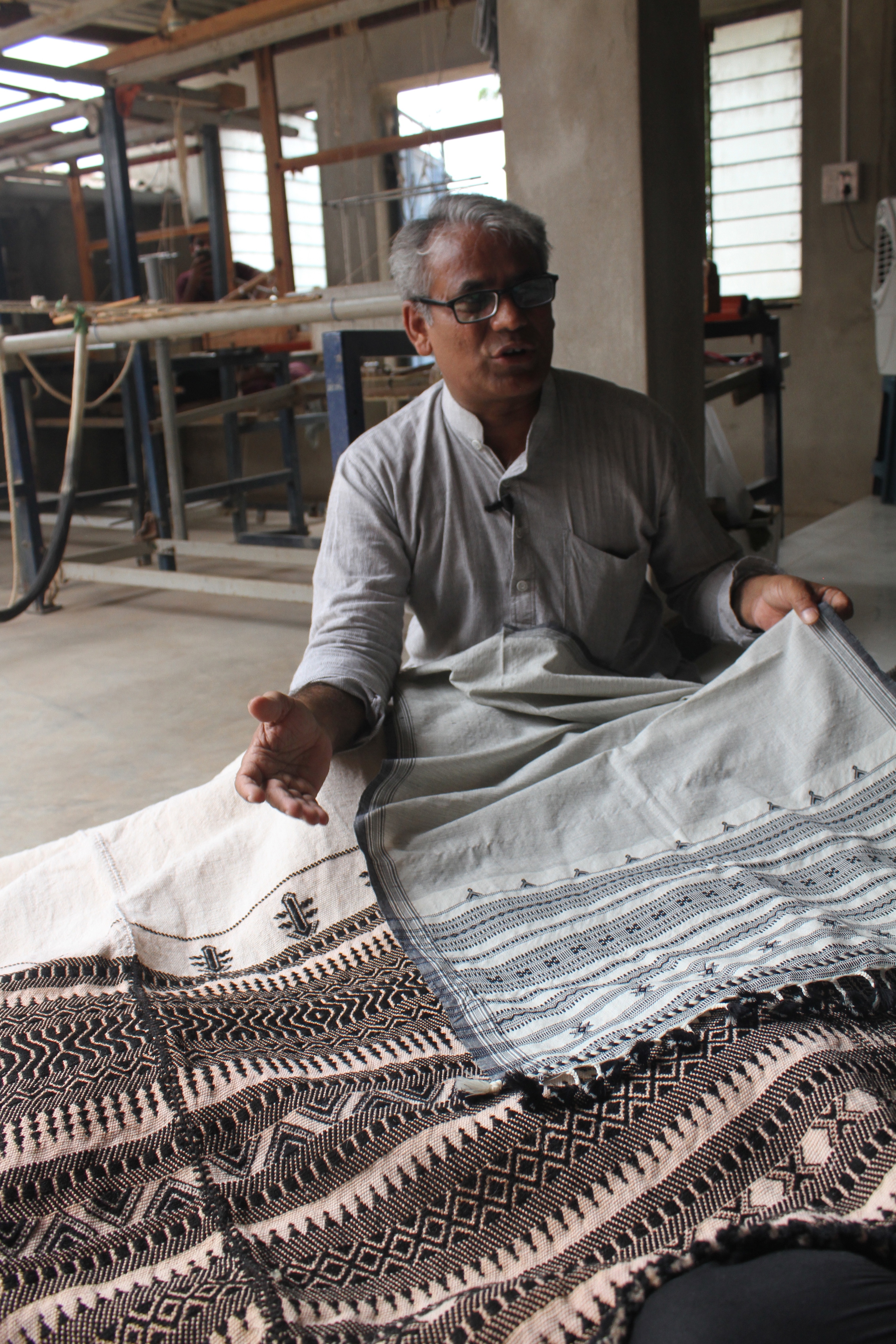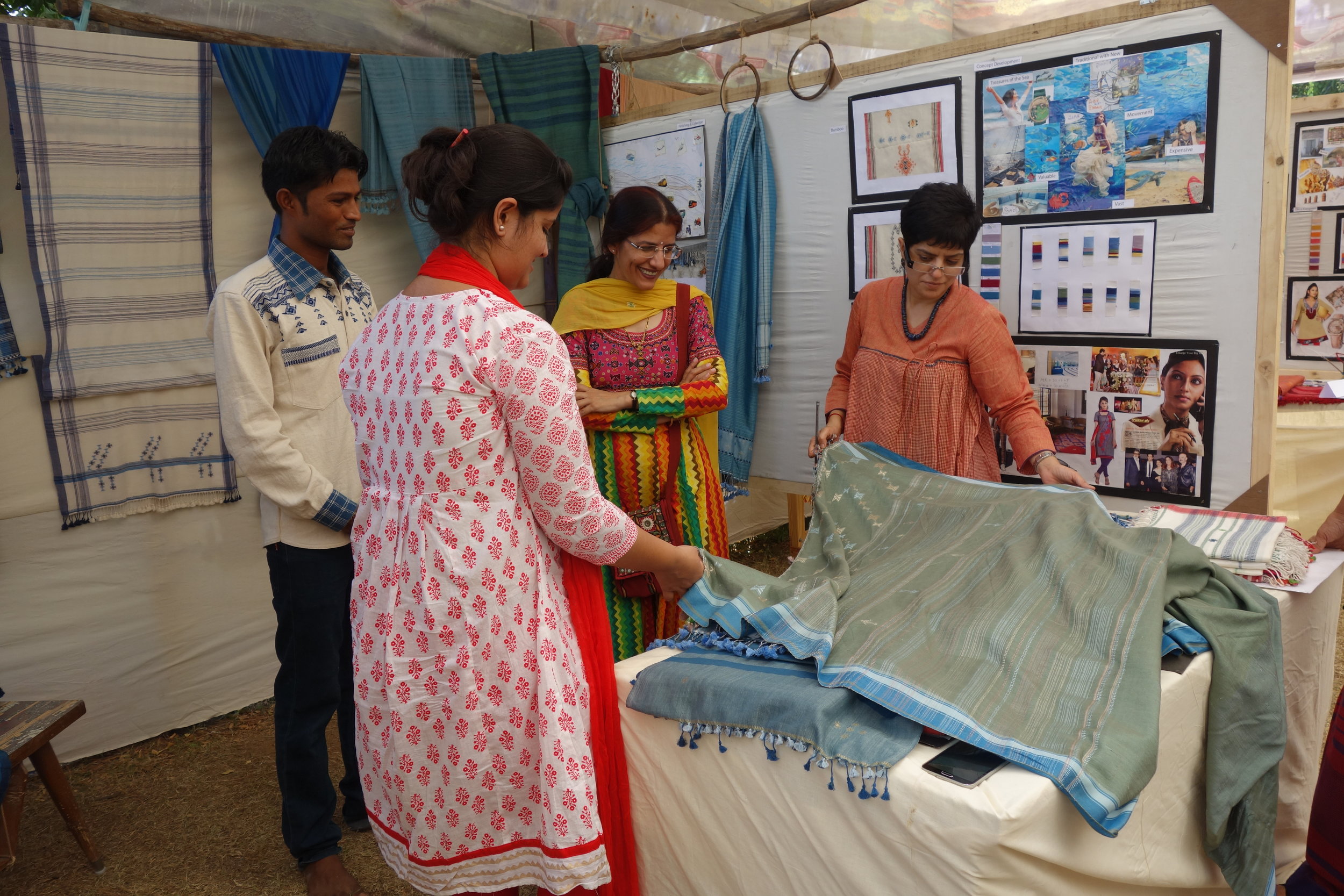Notes from the Field: Kutch and Maheshwar Weaving
This article is part of a series sharing the results from the inaugural FSJ Research Grant, which supports Master’s students, PhD candidates, early career researchers, and independent researchers working within the fields of fashion design and fashion studies.
On a cool New Year’s Day in Bhujodi village, Kutch district in Gujarat, I started weaving my first length of fabric after four days of preparing the warp, starching, bobbin winding and joining. Before starting a new warp, a puja (act of worship) is performed to bless the loom and pray that the weaving will go well. The day was an especially auspicious one, being the first of the new year. The puja is dedicated to Lord Ganesh, whose name is used to refer to the sturdy post that holds the warp in place. Aarti is performed with lit ghee, and offerings of rice and ladoo are placed beside Ganesh. Several other weavers and neighbors came by to join in the ceremony.
My teacher Jentilal demonstrated the weaving motion while I watched carefully. He made it look easy, as had the other weavers I had observed during my fieldwork. I sat on the folded quilt on the earthen ground and swung my feet into the pit. The wooden pit looms in Kutch are built for production, so use a fly-shuttle. The looms are about 50 inches wide and the shuttle is chunky with a sharp pointed end to ensure fast and smooth passing through the shed (the space between the two sets of warp yarns), but the sharp metal point also makes it easy to break threads if you don’t open the shed wide enough. It is important to push the pedals firmly to the ground to create a wide enough shed. Instructions were given both verbally and through action and imitation. I was instructed to keep my right hand, which was holding the mutiya (chord attached to the fly shuttle), close to the loom and my left hand in the middle of the pankha (beater) and pushed the pankha as far back as possible, so there was enough depth to pass the shuttle through. Then as I pulled the pankha to beat the cloth, I simultaneously swapped feet so that as the pankha pushed back as I passed the shuttle across the opposite way.
This process not only involves the hands, arms and feet, but the whole body. Weaver Meghji says “weaving is like yoga. It involves the whole body and mind. If all are not coordinated it doesn’t work.” When a weaver is proficient, the body and loom conjoin into a seamless entity and the process is fast and rhythmic like a dance.
““Weaving is like yoga. It involves the whole body and mind. If all are not coordinated it doesn’t work.””
My teachers Jentilal, Purushottam, Prakash, Rajesh and Nitesh, are all traditional weavers from Bhujodi village, 9km east of the city of Bhuj in Kutch, and all are graduates of Kala Raksha Vidhyalaya (KRV), a design school for artisans. KRV was founded in 2005 by Judy Frater, 12 years after she founded the Kala Raksha Trust that works with local artisans to develop their crafts for contemporary markets. In 2014, Frater took the curriculum to a new institute, Somaiya Kala Vidya (SKV). The curriculum consists of six two-week courses spread over one year: Basic Design, Color, Marketing, Concept Development, Finishing and Presentation and Merchandising. In between each course, students return home and apply the concepts they have learned to their own practices.
Together, KRV and SKV form one of the two case studies for my PhD research which analyses design education for artisans in India. The other case study is The Handloom School (THS) in Maheshwar. These institutes are the first of their kind to offer a long term formalized curriculum to traditional artisans in rural areas, connecting them directly with contemporary high-end markets. They challenge the divides that have emerged between urban educated designers and rural artisans working to develop traditional crafts – the second largest employment provider in India – for markets distant to the artisans’ own milieu. The aim of this research is to present an in-depth analysis of each institute, drawing out the successes and challenges of each to determine their effectiveness in nurturing innovation and entrepreneurship, and leading to viable and desirable occupations in handloom.
The Methodological Approach: Negotiating Time and Place
The main methodological challenges I faced when embarking on this study was deciding which discipline should inform the approach. I am based in an Art and Design department, have a textile design background and it was my interest in the textile objects themselves, their aesthetic, techniques, materiality and cultural significance, that informed the initial motivations for the research. But to achieve my aims and objectives, it was essential to draw upon development studies, anthropology, material culture studies, design history and education. Thus, an additional apprenticeship, this time primarily auto-didactic, involved learning about the key discourses within these disciplines that related to the subject of handloom weaving and education in India.
I adopted ethnography to capture the experiences of student-weavers studying at the institutes as well as graduates and established weaver-entrepreneurs or weaver-designers. In addition to observation in the classrooms, weavers’ workshops and sites of retail or exhibition of the woven pieces, I conducted interviews with weavers, faculty and other institute stakeholders. I also adopted visual ethnography to capture weavers’ interactions with their designs on film, as well as to document the weaving process in both areas. Anthropological studies of craft communities and ways of learning, such as those by Bunn (1999), Dilley, (1999), Ingold, (2000) and Marchand (2008), informed my decision to undertake an apprenticeship in weaving. While these authors work within the anthropology disciplinary criteria of immersing themselves into the community, spending at least a year conducting participant observation (in these cases apprenticing in craft) and interviews to gather the research, my research demanded a much more multi-sited approach. My weaving apprenticeship lasted three weeks, not at all long enough to become an expert. However, gaining some knowledge of the techniques and processes facilitated conversations with weavers and led to an understanding of the routes that lead to mastery. The course itself was also useful for getting to know better the rhythms and routines of the village, and facilitating spontaneous conversation.
Thinking about how I would combine ethnography, two case studies and the multiple locations the study spread across, I found the term ‘ethno-case study’ useful. The term was used by Marie Parker-Jenkins based on her observation of the overlaps between ethnography and case study method, as well as the evolving and dynamic nature of ethnography. It also relates to the postmodern and globalized way that communities have become de-centred and dispersed, which is indeed the case for the participants of this study. Thus, ethnographic research can be “multi-sited and conducted through condensed/intense periods of time in the field” [1].
The two sites of Kutch and Maheshwar have become diverse and globalised spaces, both receiving increasing numbers of visitors. Crafts are a significant attraction for visitors to Kutch, as well as the wildlife, history and the landscape. Maheshwar receives religious pilgrims, tourists shopping for saris and day trippers who come to see the fort and ghats of the holy river Narmada. For fashion and textiles buyers and designers, these regions are ‘destination places’. Designers and buyers like to visit between the festivals of Diwali and Holi when the temperatures are pleasant.
By maintaining ways of weaving on looms that have changed little over the past few centuries, weavers are often viewed as symbols of traditional heritage in craft development and promotional narratives. The woven products, specifically the Geographically Indicated (GI) Kutchi shawl and Maheshwari sari are valorized based on their locality [2]. Yet, large numbers of weavers for whom craft is their hereditary occupation are leaving in search of “modern” occupations, mainly office jobs in cities.
However, weavers’ roles are much more nuanced and their options situated along a much more populated continuum than the polar opposites of “modern” office work and “traditional” weaving in the village. Those weavers who have continued weaving, particularly graduates of SKV and THS traverse different spaces, roles and identities. They travel to cities for exhibitions or to meet buyers, and some also travel abroad. Students on the SKV course travel to Ahmedabad to visit middle to high-end stores. For THS students, many of whom have come from different parts of India to Maheshwar, it is their first time interacting with weavers from other regions as well as with buyers and designers who visit the campus, facilitating cultural exchange and collaborative learning.
The majority of weavers I met are also well-connected and savvy and use social media and the internet to promote their work, gaining clients and maintaining effective communication mostly via WhatsApp. Interaction in these spheres has been significant in challenging social and cultural barriers. Fieldwork therefore involved traveling to these places to observe and build understanding of not only the process of learning weaving, design and business, but also how this knowledge is developed in new communities of practice: the campus, shops, galleries, exhibitions and meetings with buyers.
Reflexivity and Roles
Recognizing weavers’ social mobility and cultural capital helped me to negotiate my own presence as a white, formally educated middle-class woman in rural regions which in the past have been sites of romanticization and othering in both colonial and post-colonial contexts. It was important for me to enter the field with a fresh, but critical eye, shed of any preconceptions about “traditional” communities or ideas about development. I harbored anxiety over how much to comment on participants’ designs when they asked for advice or feedback, based on problematic imbalances and stereotypical oppositions between designers and artisans, east and west, or formal and informal education.
I therefore found it important to acknowledge commonalities between myself and the research participants, particularly a shared understanding and appreciation for textile design. If there was any imbalance, it lay with the weaver having a high level of skill in weaving as well as design and business, while I was a designer-turned-researcher, and the purpose of my research may not have been understood or be deemed important to the participants. Many participants however, did think that the research outputs would be good promotion for their work, by being disseminated within academic and non-academic audiences.
Nevertheless, the woven textiles, as "social objects, served as tools for communication and as many weavers themselves recognized, design itself can act as a common language across cultures and communities. This recognition also formed part of an effort to acknowledge their agency in taking their craft in the direction they saw most appropriate. Indeed weavers’ roles could involve that of karigar (skilled artisan), master artisan, entrepreneur, designer or weaver, and many individuals will also move between these roles, or combine them with completely different jobs or study [3].
As a researcher/ethnographer, I did not have a fixed agenda like the development practitioners and designers I would meet in these areas, who were working to production times, costs, training or teaching, sales and designs. I was asking questions, having conversations, often helping out with teaching and offering design advice. My final document will not come up with a specific way of working or find any all-encompassing answer to the relevance of local knowledge and craft practices in the contemporary world or how they should be nurtured or developed. However, I hope the research will be an important contribution to academic and wider discourses around craft development by inter-referencing areas of craft development and education (which until recently have been largely treated as two distinct areas), and several other disciplines, and therefore challenge existing discourses that presents craft as diametrically opposite to design and artisans as ‘outmoded’ or in need of “help” [4]. It is hoped that aspects of the research will be universally recognized and that the in-depth analyses of the two education institutes will inform efforts in other regions where craft is an important livelihood generator.
Acknowledgements
I would like to acknowledge the following people for their invaluable support during the aspect of the research I’ve focused on: Judy Frater, founder/director of Somaiya Kala Vidya and Lokesh Ghai, SKV trustee and visiting faculty, for coordinating the weaving course and for supporting with interpretation; and Jentibhai, Purushottambhai, Prakashbhai, Niteshbhai and Rajeshbhai for their hard work, patience and enthusiasm. For more information about SKV’s craft courses, see SKV’s website. There are too many more people to mention here who contributed to, or supported the whole research project: weavers, faculty, staff, collaborators, jury members and stakeholders of the two institutes, as well as experts in craft development across India. This research could not have been done without them.
Notes:
[1] Parker-Jenkins, M. (2018) ‘Problematising ethnography and case study: reflections on using ethnographic techniques and researcher positioning’, Ethnography and Education, 13(1), 22. DOI: 10.1080/17457823.2016.1253028
[2] The Geographical Indication (GI) is a government initiative to protect a product thought to be traditional to a particular region from being imitated, either in other regions, or in the case of handloom products, by machines or powerlooms. Widely debated, the GI is criticized for continuing the narrative of an idealized historicized identity of crafts, fixing them in this category and preventing dynamism (Kawlra, 2014; Basole, 2014; Sethi, 2016). The ‘Kachchhi shawl,’ a modern term given to the adaptation of the dhabla and ludi, products woven for local clients, was given GI status in 2011, after the NGO Khamir CRC along with Kutch Weavers Association, formed by a group of weavers submitted an application (Government of India, 2011). The Maheshwari Sari was given GI status in 2012 and lists features such as the particular counts of mercerized cotton and silk, the inclusion of zari (metallic yarn).
[3] The term master weaver is usually used to describe a skilled weaver and business owner employing other weavers, but the activities the master-weaver takes on can vary.
[4] Mamidipudi, A. and Gajjala, R. (2008) ‘Juxtaposing handloom weaving and modernity: building theory through praxis’, Development in Practice, 18(2), 235–244. DOI: 10.1080/09614520801899069.
References:
Basole, A. (2015) ‘Authenticity, Innovation and the Geographical Indication in an Artisanal Industry: The Case of the Banarasi Sari’, The Journal of World Intellectual Property. St. Louis: Federal Reserve Bank of St Louis, 18(3–4), pp. 127–149. Available at: http://search.proquest.com/docview/1698749399?accountid=14693.
Bunn, S. (1999) ‘The Nomad’s Apprentice: Different Kinds of Apprenticeship among Kyrgyz Nomads in Central Asia’, in Ainley, P. and Rainbird, H. (eds) Apprenticeship: Towards a New Paradigm of Learning. London: Kogan Page, pp. 74–85.
Dilley, R. (1999) ‘Ways of Knowing, Forms of Power’, Cultural Dynamics, 11(1), pp. 33–55. doi: 10.1177/092137409901100103.
Indications, G. of I. G. (2011) ‘Kachchh Shawl - GI Application no. 174’, Geographical Indications Journal. (Intellectual Property India: Geographical Indications Registry), pp. 7–20. Available at: http://ipindia.nic.in/girindia.
Ingold, T. (2000) The Perception of the Environment: Essays on Livelihood, Dwelling and Skill. London: Routledge.
Kawlra, A. (2014) ‘Duplicating the local: GI and the Politics of “Place” in Kanchipuram’, Perspectives in Indian Development. Nehru Memorial Museum and Library. Available at: https://www.academia.edu/7635756/Duplicating_the_Local_GI_and_the_Politics_of_Place_in_South_India.
Mamidipudi, A. and Gajjala, R. (2008) ‘Juxtaposing handloom weaving and modernity: building theory through praxis’, Development in Practice, 18(2), pp. 235–244. doi: 10.1080/09614520801899069.
Marchand, T. H. J. (2008) ‘Muscles, Morals and Mind: Craft Apprenticeship and the Formation of Person’, British Journal of Educational Studies, 56(3), pp. 245–271. doi: 10.2307/20479601.
Parker-Jenkins, M. (2018) ‘Problematising ethnography and case study: reflections on using ethnographic techniques and researcher positioning’, Ethnography and Education, 13(1), pp. 18–33. doi: 10.1080/17457823.2016.1253028.
Sethi, R. (no date) ‘In Praise of the Real Thing: Some thoughts on IPR and GI’, Craft Revival Trust. (Craft Revival Trust). Available at: http://www.craftrevival.org/voiceDetails.asp?Code=335.







